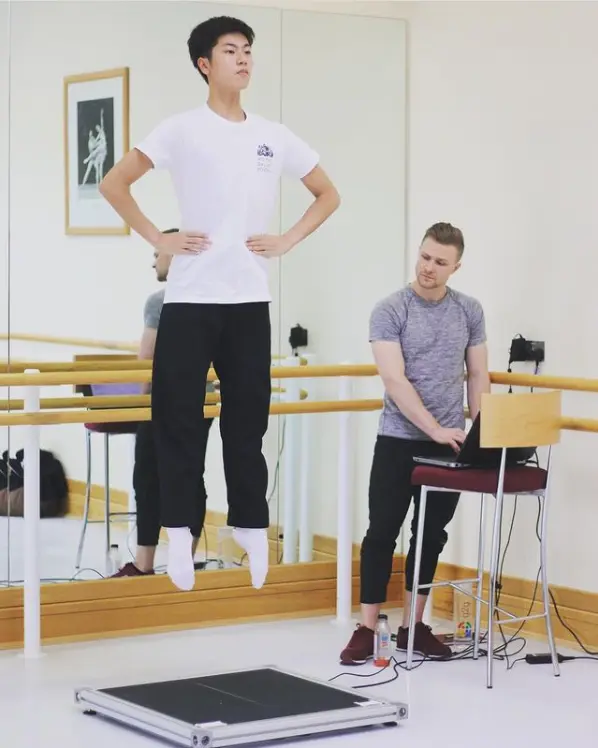Testing neuromuscular strength of pre-professional ballet students with ForceDecks: Royal Ballet School
Available in:
EN
The Royal Ballet School has integrated ForceDecks to regularly test its ballet students, ranging from ages 11 to 19 years old, to track and monitor neuromuscular strength and provide rehabilitation.

Snapshot
In this case study, we sat down with Matthew Lamarque (Strength and Conditioning Coach, The Royal Ballet School) to explore how ForceDecks have provided the Healthcare and Artistic staff with insightful metrics to guide their programs and training for ballet students; and how the ballet students have interacted with the use of ForceDecks testing.
Which ForceDecks tests are used to test the ballet students?
Metrics used to test performance.Four main ForceDecks assessments, among other less frequent tests are used:
- Bilateral jumps
- Unilateral jumps
- Unilateral isometrics tests in two different positions: a standing plantarflexion to give insight into dancer calf strength and a single leg squat to provide insight into more holistic leg strength.
Metrics used for rehabilitation.The other tests The Royal Ballet School use are the:
- Athletic shoulder test
- Isometric mid-thigh pull
- Isometric posterior chain test (the McCall Test).
These tend to be used for more of an individual or rehabilitation level test.

How often are ForceDecks testing sessions performed and what kinds of indicators are used?
Vertical jumps and single leg isometric testing are tested every three months from a performance and profiling perspective for all students across The Royal Ballet School. Overall, The Royal Ballet School is testing over 220 athletes, three times each training year.Lamarque emphasises that “This gives myself and my colleague Niall MacSweeney a large insight into the physical development of our dancers and allows us to start building normative data for our environment.”Notably, Lamarque runs weekly fatigue monitoring tests for older dancers from the ages of 16 to 19:“This is a pretty new initiative with dance science and to my knowledge we are the only organisation in classical ballet to run a weekly fatigue monitoring test, which came about as the result of a Masters of Research (MRes) project in January 2019.”
The main metrics for jump tests include:+ Jump height+ Peak power relative to body weight+ Take-off peak force+ Impulse+ Peak landing force+ Peak landing force asymmetryThe main metrics for isometric tests include:+ Peak vertical force+ Peak vertical force relative to body weight+ Rate of force development / impulse during different time points
How have ForceDecks changed the way the Royal Ballet School trains and manages its ballet students? An increased insight into metrics has allowed The Royal Ballet School to reliably individualise supplementary training for the ballet students, giving them a “clear direction into deficits or large asymmetries.”
The metrics not only guide the rehabilitation programs, but also for strength and conditioning sessions where the dancers will work on individual programs. An example of this is if a ballet student’s jump metrics are power dominant, however their overall force output or rate of force development is poor, that will guide the programming for the dancer.

Lamarque elaborates, “Throughout the MRes research project, it was identified that the neuromuscular performance markers were more sensitive to changes in weekly training loads than perceptual wellbeing markers (e.g. muscular soreness and fatigue) in this adolescent population. As a result, The Royal Ballet School uses this neuromuscular insight to fatigue alongside daily wellbeing to develop a holistic understanding of each dancer’s training.”

How have the ballet students interacted with the ForceDecks?
Lamarque expresses that The Royal Ballet School’s students are eager to do ForceDecks testing, and have a keen eye for comparing their results for each test:“The ballet students at The Royal Ballet School have been open to seeing the metrics after their ForceDecks tests and are keen to compare their metrics for each test. Others want to know why their numbers might be different to the previous test, and this provides me an opportunity to provide the context.As dancers, the level of intrinsic or kinesthetic awareness is high, and they will know if a test feels good. In terms of the jumps, they’re straight over to the laptop to see their height, and when isometric testing, they are often aware if one limb is better than the other and we can enter a positive dialogue of what that means for them and the direction their strength and conditioning training will go in. ”

About Royal Ballet School
The Royal Ballet School, based in the United Kingdom, is a classical ballet school that educates and trains outstanding ballet dancers for The Royal Ballet, Birmingham Royal Ballet, and other leading international companies (The Royal Ballet School website, 2021).
About Matthew Lamarque
Matthew Lamarque graduated from St Mary’s University, Twickenham with a Bachelor of Strength and Conditioning Science and more recently a Masters of Research (MRes) in Sport, Health and Applied Science investigating training loads in adolescent classical ballet. He has a background working as Strength and Conditioning Coach in the elite sports industry, including in cricket, soccer and rugby union and is now training adolescent classical dancers at The Royal Ballet School for careers in professional ballet companies
References
The Royal Ballet School website. (2021). The Royal Ballet School home page. Retrieved 13 April, 2021 from royalballetschool.org.uk©2019 The Royal Ballet School. Photography by Tristram Kenton.Screenshot from The Royal Ballet School’s Healthy Dancer Programme film.
Interested in learning more about ForceDecks?
Fill in the contact form here or see the button below.
